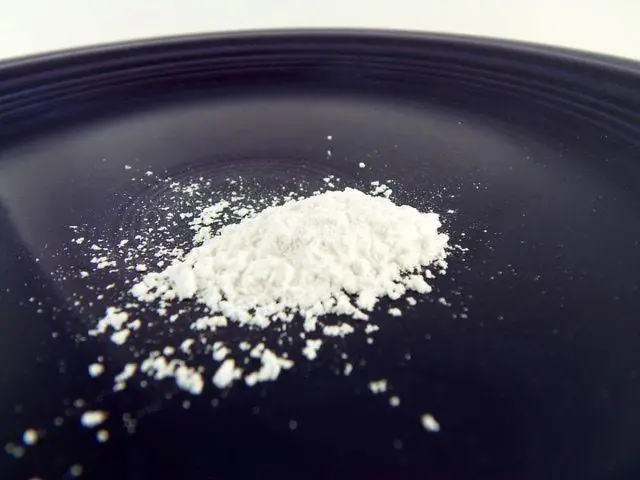
Table of contents:
- Author Bailey Albertson [email protected].
- Public 2023-12-17 12:53.
- Last modified 2025-01-23 12:41.
One toe overlaps the other: what is the reason and how to treat

If a toe overlaps another toe, this is not only an aesthetic problem. Such a curvature may indicate the development of a dangerous pathological process in the body. In addition, there is a risk of corns, calluses and other troubles. It is imperative to find out the cause of this condition and try to eliminate it.
Why do my toes overlap
Deformation of the foot can be provoked by various pathological conditions. A qualified orthopedist will help to identify the exact cause
Hallux valgus
The people call this pathological process "a bone on the leg." This is a common disease known to many. More often women suffer from it. Initially, the phalangeal joint of the first (thumb) toe is bent. If therapy is not started in time, other fingers begin to bend, which entails great discomfort when walking.

Hallux valgus - a pathology that women most often face
Hallux valgus develops gradually. Initially, shoes of the usual size become uncomfortable, painful sensations appear in the legs at the end of the day. Over time, the bone near the big toe increases, the curvature of the entire foot is observed. In the absence of therapy, irreversible changes occur. It is possible to restore the condition of the foot only through surgery.
All women in our family on the maternal side have a "bone" on the leg. We have to experience big problems when choosing shoes. In addition, after a long walk, the feet begin to hurt.
Arthrosis
This is a common disease of the musculoskeletal system associated with the gradual destruction of joints. The pathology can be diagnosed both in the elderly and in young patients. The disease is provoked by the following negative factors:
- violation of blood supply to the feet against the background of excess weight or frequent use of uncomfortable shoes;
- violation of the hormonal background of the body;
- different leg lengths, flat feet;
- diabetes.
My grandmother suffered from arthrosis of the feet. Already by the age of 60, her fingers were twisted so badly that she could not fully move without a special cane.
Convulsions
A sharp muscle contraction, accompanied by severe pain, can be observed against the background of overwork of the legs. With cramps in the legs, the fingers often overlap, but this symptom is temporary. Once the muscles relax, the fingers return to their normal position.

If you have frequent leg cramps, you should see a doctor.
If the convulsions recur regularly, you cannot postpone the visit to the doctor. This symptom often indicates a deficiency of vitamins and minerals. In addition, sudden painful muscle contractions can indicate chronic disorders in the body.
During pregnancy, I often suffered from leg cramps at night. The toes were badly bent. But after 3-5 minutes, the state of the feet returned to normal.
Congenital features of the foot
In some cases, the baby may already be born with an irregular foot. This condition can be observed when the fetus is in the wrong position in the womb. If one finger overlaps the other, while the child's gait does not suffer, there are no other pathologies, this can be considered a variant of the norm.
What to do if a toe overlaps another toe
Changes in the shape of the foot, painful sensations when walking, frequent cramps - all this is a reason for seeking medical help. The specialist will find out the cause of the pathological condition of the feet and prescribe the appropriate treatment. With a timely request for help, it will be possible to restore the condition of the feet in a conservative way. Medicines are used that normalize blood circulation in the tissues, restore the condition of the joints. Additionally, physiotherapy procedures can be prescribed.

Silicone pads help prevent further deformation of the foot
The following preventive measures will help reduce the likelihood of further deformity of the foot:
- use of soft, comfortable shoes with orthopedic insoles;
- weight control;
- proper nutrition;
- moderate physical activity.
With congenital deformity of the foot, if the defect does not cause painful sensations and problems with the spine, there is no need for special therapy.
Curvature of the toes is a pathology that cannot be ignored. Seeing a doctor at an early stage will help avoid complications and restore a beautiful appearance to your legs.
Recommended:
How To Clean A Phone Case (silicone Or Other Material), White Or Other Colors

What materials are phone cases made of? What products can be used to clean silicone, plastic and other materials
How To Make A Clothes Dryer With Your Own Hands Or Choose, Assemble And Install A Ready-made (ceiling, Floor, Liana Or Other), Other Tips

Dryers for clothes: floor, ceiling, wall - how they differ. How to choose the right one or assemble it yourself, including from scrap materials
How To Replace Baking Powder For Dough In Baking: Slaked Soda And Other Options For Cake, Biscuit And Other Products + Photos And Videos

How to make lush baking can be done without baking powder at home. What to replace. Useful Tips
How To Ignite A Cast Iron Pan Before The First Use And In Other Cases: Salt, Oil And Other Methods + Photos And Videos

How to ignite cast iron pans. Quick ways to get rid of engine oil residues, rust and carbon deposits
A Cat Or A Cat Often Goes To The Toilet For A Little Bit: Causes Of Frequent Urination, Diagnosis And Treatment Of Possible Diseases

The amount of urination in cats is normal. Frequency of urination is physiological and in case of illness. A sign of what pathologies can be. How to help your pet
